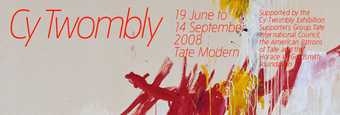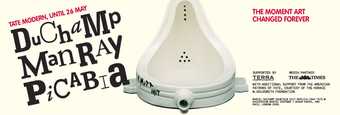Philippe Parreno’s The Writer 2007 (fig.1) is a video, played on a screen the size of a painted miniature, of the famous eighteenth-century Jaquet-Droz automaton recorded in the act of writing with a goose quill pen. Zooming in on the automaton’s hand and face, Parreno contrives to produce a sense of uncertainty as to the human or robotic nature of the doll. It is an example of a contemporary fascination with cyborgs and with the increasingly blurred dividing line between machine and organism. In a manner worthy of surrealist artist René Magritte, Parreno plays on the viewer’s sense of astonishment. As the camera rolls, the android deliberates before slowly writing: ‘What do you believe, your eyes or my words?’ The ‘Écrivain’ is one of the most celebrated automata that enjoyed a huge vogue in Enlightenment Europe. In a lavish two-volume book, Le Monde des automates (1928), Edouard Gélis and Alfred Chapuis define the android as ‘an automaton with a human face’.1 A chapter of this book, which supplied the illustrations for an article in the surrealist journal Minotaure, is devoted to drawing and writing automata.2 The oldest example Gélis and Chapuis cite was fabricated by the German inventor Friedrich von Knauss whom, they state, laboured at the problem of ‘automatic writing’ for twenty years before presenting his first apparatus in 1753.3
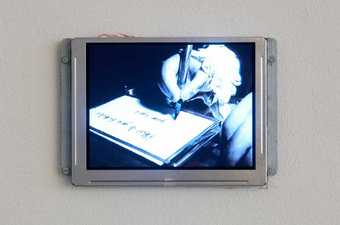
Fig.1
Philippe Parreno
The Writer 2007
Photographic still from DVD
3:58 minutes
Courtesy the artist and Haunch of Venison, London © Philippe Parreno
This article takes up the notion of mechanism that is implicit in the very word automatism. The impulse to become a machine is something that shall be examined with respect to the surrealist practice of automatic writing and drawing before turning to some contemporary instances. The latter-day instantiations of automatic techniques that will be discussed hark back to surrealism, prompting us to reflect upon and question what was at stake in their use of the technique.4
The graphic trace
From the mid-nineteenth century onwards, recording instruments became vital tools in the production of scientific knowledge in a range of disciplines that were of direct relevance to surrealism. Such mechanical apparatuses, synonymous with the values of precision and objectivity, quickly became the benchmark of an experimental method. The inexorable rise of the graphic method has been intensively studied by historians of science and visual culture, but surrealism has not yet been considered as partaking of this transformation in the field of visual representation. In what follows, recording instruments are shown to have helped to underwrite surrealism’s scientific aspects and bolster its credentials as an experimental avant-garde.
The graphic method inaugurated a novel paradigm of visual representation, one geared towards capturing dynamic phenomena in their essence. It was the product of a radically new scientific conception of the physical universe in terms of dynamic forces, a world view that is doubtless at some level a naturalisation of the energies, both destructive and creative, unleashed by industrial capitalism.5 The proliferation of mechanical inscription devices in the life sciences coincided with the displacement of anatomy, as a static principle of localisation, by physiology, which analysed and studied forces and functions. Étienne-Jules Marey, known today as an inventor of chronophotography, was one of the main exponents of the graphic method in France, and he personally devised a number of instruments whose aid, he wrote, made it possible to ‘penetrate the intimate functions of organs where life seems to translate itself by an incessant mobility’.6 As an apparatus for visualisation, the graphic method carries implications for how to construe figures of the visible and invisible. It was not simply a technology for making visible something that lay beneath the human perceptual threshold (like a microscope), but rather a technology for producing a visual analogue – a translation – of forces and phenomena that do not themselves belong to a visual order of things.7
At its simplest, a frog’s leg muscle is hooked directly to a pointed stylus that rests on a drum whose surface is blackened with particles of soot from a candle flame (fig.2). An electrical stimulus causes the muscle to contract, deflecting the stylus and thus producing on the revolving drum a typical white on black curvilinear trace. Fatigue of the muscle produces an increased duration and diminished amplitude of successive contractions, as shown in the figure at the bottom. A more sophisticated device pictured by Marey consisted of a flexible diaphragm, a sort of primitive transducer, connected by a hollow rubber tube to a stylus, which inscribed onto a continuous strip of paper. At the heart of the graphic method is the production of a visible trace.8 A stylus roving back and forth on a rotating cylinder or a moving band of paper translates forces into a universal script that Marey regarded as ‘the language of the phenomena themselves’ and which he proclaimed is superior to the written word.9 In an era where quantitative data gradually became the common currency of scientific discourse, Marey considered written language, ‘born before science and not being made for it’, as inadequate to express ‘exact measures and well-defined relations’.10 The incorporation of a time axis owing to the continuous regular movement of the drum lends a distinctive property to the graphic trace. The historian Robert Brain remarks that ‘the graphic representation is not an object or field like that of linear perspective, but a spatial product of a temporal process, whose order is serial or syntagmatic’.11 Units of time are marked off at the bottom of the myographic trace as regular blips on a horizontal axis; additionally, the passage of time is registered in the palimpsest-like layering of successive traces.12
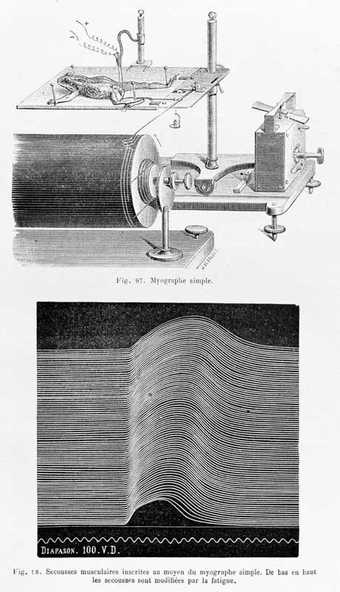
Fig.2
Simple myograph (top) and trace of repeated muscular contractions (bottom)
From Etienne-Jules Marey, La Méthode graphique dans les sciences expérimentales et principalement en physiologie et en médecine, Paris 1875, p.194
From its initial applications in physiology, the graphic method soon made inroads into areas such as medicine and psychology, eager to prove their scientific legitimacy. The familiar chart of a patient’s temperature, pulse, and respiration had become standard fare in hospital wards by the mid-nineteenth century.13 Marey went so far as to predict that the visual tableau comprised of such ‘medical curves’ would replace altogether the written record. The growth of medical specialties saw doctors attempting to justify their status and claims to authoritative knowledge by adopting the tools-in-trade of an experimental science. The Salpêtrière Hospital in Paris, under neurologist Jean-Martin Charcot, was at the forefront of these developments, and graphic traces are liberally interspersed among the better-known photographs, engravings, and fine art reproductions of Charcot’s book Iconographie de la Salpêtrière (1878). Employed first for the investigation of muscular and nervous disorders, the myograph was subsequently applied by Charcot to the study of hysteria. By enabling the hysterical attack to be objectively recorded in the form of a linear visual narrative, the graphic trace performed an invaluable service in conferring a semblance of reality upon a condition that was widely dismissed as mere playacting or simulation (fig.3).
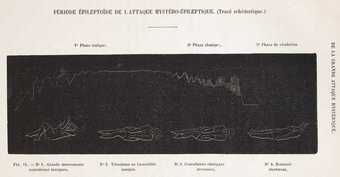
Fig.3
Epileptic phase of an hysterical attack
From Paul Richer, Études cliniques sur l’hystéro-épilepsie ou grande hystérie, Paris 1885, p.40.
Nearer in time to the surrealists, the hysteria problem was revived with particular urgency in the guise of shellshock, and there again physicians placed their faith in the graphic method as a means of reliably excluding simulation where clinical observation alone was of no avail. Evidence of the surrealist André Breton’s first-hand acquaintance with such devices is not hard to find. Soon after his arrival at the neuro-psychiatric centre at St Dizier in August 1916 he writes excitedly to Théodore Fraenkel, a fellow medical student, saying that all his time is devoted to examining patients. He details his technique for interrogating his charges and in the same breath adds ‘and I manipulate the sphygmometric oscillometer’.14 The instrument to which Breton refers gives a measure of the peripheral pulses and would have been used by him to detect an exaggerated vascular response to cold that was held to be a diagnostic feature of reflex nervous disorders. There is a reasonable likelihood that Breton also came in contact with the use of a myograph for the same purpose, either at St Dizier or the following year when he was attached as a trainee to neurologist Joseph Babinski’s unit at the Pitié Hospital in Paris. Breton possessed a copy, with a personal dedication from the authors, of Babinski and Jules Froment’s Hystérie-pithiatisme et troubles nerveux d’ordre réflexe en neurologie de guerre (1917), a textbook profusely illustrated with myographic traces.
As a newly formed discipline, psychology was also quick to integrate the paraphernalia of experimental physiology.15 Alfred Binet, one of the pioneers of psychology in France, employed the graphic trace as an instrument more sensitive in his opinion than automatic writing for revealing a dissociation of the personality in cases of hysteria. ‘In following our study of the methods that enable us to reveal this hidden personality’, Binet writes, ‘we are now to have recourse to the so-called graphic method, the employment of which, at first restricted to the work-rooms of physiology, seems, at the present time, destined to find its way into the current practice of medicine’.16 The definition of psychology as experimental is seen to be closely tied with the use of a measuring instrument. Binet’s goal appears to be an almost paradoxical exclusion of the subject, with its nigh infinite capacity for dissimulation, from the scientific investigation of that subject’s own subjectivity. Coinciding with the introduction of quantitative forms of measurement, introspection rapidly fell into disrepute as a method of inquiry. Robert Brain’s observation that in the field of psychology ‘the graphic method served both as a research tool and a source of analogies for investigating mental activities’ is certainly to be borne in mind with regard to surrealism.17
Alongside mainstream science, recording devices also made incursions into psychical research. The use of such apparatuses to restrict the latitude for fraud contributed to the general air of scientific enquiry. The historian Richard Noakes has shown that the intractable problems of researching mediums, their notoriously capricious and untrustworthy nature, led some experimenters to suggest that sensitive instruments alone could replace the human subject as a means of accessing the spirit world.18 In the 1870s, William Crookes, a respected chemist and a pioneer in the application of measuring instruments to spiritualist research, devised an apparatus for recording emanations from the body of the medium Daniel Dunglas Home, as a result of which he claimed to have discovered a mysterious new form of energy, which he termed ‘Psychic Force’ (fig.4).19 A Marey drum was used to make physiological recordings of the medium Eusapia Palladino, who had been often exposed for cheating in the past, during a highly publicised series of séances conducted under controlled experimental conditions at the laboratories of the Institut général de psychologie in Paris.20
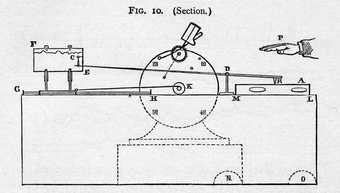
Fig.4
Apparatus for recording the emanation of psychic force from a medium.
From William Crookes, Researches in the Phenomena of Spiritualism, London 1874.
Modest recording instruments
It would appear that surrealism was not indifferent to the lure of the graphic method. The particular aspect to foreground here is the promise of objectivity. The graphic method offered the prospect of bypassing altogether the human observer who was increasingly liable to be viewed as a source of error in scientific experiment. With precision and objectivity the yardsticks of science by the latter part of the nineteenth century, the historian Peter Galison remarks that ‘the machine as a neutral and transparent operator … would serve as instrument of registration without intervention and as an ideal for the moral discipline of the scientists themselves’.21 Addressing the graphic trace in these terms, Marey strikingly adumbrates the language of surrealism in remarking that ‘one endeavoured to write automatically certain phenomena’.22 The surrealists spoke of their art and literary productions as objective documents and advocated an objective stance that sidelines the authorial subject who was meant to be as near as possible a passive onlooker at the birth of the work. Or, in Breton’s words, a modest recording device: ‘we, who have made no effort whatsoever to filter, who in our works have made ourselves into simple receptacles of so many echoes, modest recording instruments not mesmerised by the drawings we are making.’23 Closely allied with this imperative to become akin to a machine is a metaphorics of the trace and tracing: ‘here again it is not a matter of drawing, but simply of tracing’, Breton insisted in the 1924 ‘Manifesto of Surrealism’.24
The accent on objectivity is consonant with surrealism’s avant-gardist ethos of experiment, stemming ultimately from science. In fact, Breton contended that by the time the manifesto had been published, five years of uninterrupted experimental activity already lay behind it.25 Around the time of the manifesto, the surrealists set about creating a research centre of sorts, the short-lived Bureau of Surrealist Research, testifying to the earnestness of their experimental impulse. However, it was no ordinary laboratory that opened to the public at 15 Rue de Grenelle, Paris, in October 1924. The surrealist playwright and poet Antonin Artaud recalls that a mannequin hung from the ceiling and, reputedly, copies of the crime fiction volume Fantômas and Sigmund Freud’s The Interpretations of Dreams framed with spoons were enthroned on a makeshift altarpiece. The second issue of the house journal La Révolution surréaliste, the cover of which was modeled on the popular science magazine La Nature, carried an announcement of its purpose:
The Bureau of Surrealist Research is applying itself to collecting by all appropriate means communications concerning the diverse forms taken by the mind’s unconscious activity. No specific field has been defined for this project and surrealism plans to assemble as much experimental data as possible, without knowing yet what the end result might be.26
Asserting a parallel with science, as Breton was fond of doing, was a way of implying that surrealism was dedicated to finding practical solutions to vital problems of human existence, and of distancing it as far as possible from a posture of aesthetic detachment. The statement above identifies the unconscious as the privileged object of surrealist research. Automatism, from this point of view, could be understood as a research method, a set of investigative procedures that organise and govern practice but do not determine outcomes. The openness of scientific inquiry is something that may have been especially attractive to surrealism; the final clause above insists upon their refusal to define goals – a programme – which would have run the risks of a reductive instrumentalism or empty utopianism. At the same time, however, bearing in mind the extreme animosity towards positivism that Breton notoriously gives vent to in the 1924 manifesto, the dangers for surrealism of too close a proximity to science should not be overlooked. Perhaps for this reason, Artaud, in a report on the bureau carried in the third issue of the journal, argues warily for the necessity of a certain surrealist mysticism. A survey of the terms ‘research’ and ‘experiment’ in the period would reveal that much the same vocabulary was utilised in the marginal, pseudo-scientific world of spiritualism and parapsychology as by mainstream science, and it is notable that surrealist experimentation happily straddles these seemingly contradictory currents. The hypnotic trance sessions, one of the main experimental activities engaged in by the nascent surrealist group, are illustrative of this cross-over between science and the occult. 543 pages of notes and drawings obsessively documenting the sessions, which took place nightly between September and October 1922, were preserved by Breton and included among a list of artworks, books and other objects housed in the bureau.
While Salvador Dalí did not partake of the ‘birth pangs’ of surrealism, as Breton ruefully observed, his overheated imagination provides a vivid if fanciful evocation of this first phase of surrealist experiment. In an essay written in 1932, Dalí conjures up an improbable scenario of hypnotic subjects wired to recording devices like the unfortunate frog in Marey’s illustration, though in this case it is the trace of poetic inspiration that is expectantly awaited:
All night long a few surrealists would gather round the big table used for experiments, their eyes protected and masked by thin though opaque mechanical slats on which the blinding curve of the convulsive graphs would appear intermittently in fleeting luminous signals, a delicate nickel apparatus like an astrolabe being fixed to their necks and fitted with animal membranes to record by interpenetration the apparition of each fresh poetic streak, their bodies being bound to their chairs by an ingenious system of straps, so that they could only move a hand in a certain way and the sinuous line was allowed to inscribe the appropriate white cylinders. Meanwhile their friends, holding their breath and biting their lower lips in concentrated attention, would lean over the recording apparatus and with dilated pupils await the expected but unknown movement, sentence, or image.27
Dalí clearly took to heart Breton’s exhortation to his fellow surrealists that they should make themselves into ‘modest recording instruments’. Inspired by extant photographs that afford a rare glimpse of the legendary bureau, Dalí conjures up a fantastical laboratory with pliant subjects hooked to a plethora of arcane recording devices.
Beyond a serviceable metaphor employed by Breton, what evidence is there for the graphic method as having any bearing on the actual practice of automatic drawing? While scattered instances of direct citation of graphic traces can be demonstrated, what is more significant is that this novel regime of visuality, beginning as a style of scientific imaging and becoming by the time of surrealism a widely circulated and understood visual idiom, was a necessary historical antecedent in order that the automatist line might be imbued with meaning as the authentic trace of unconscious instinctual forces and energies (in its absence, they would have been literally unreadable in these terms). With the precedent of the graphic trace available to them, it was possible for surrealist artists to imagine how they might square the circle by integrating temporal duration within a static visual medium.
‘Could it be that Marcel Duchamp reaches the critical point of ideas faster than anyone else?’, wondered Breton. It is a question that can profitably be asked in examining the impact on avant-garde artists of an avowedly scientific visual idiom. Duchamp, and his artistic collaborator Francis Picabia, around 1912 to 1913 rejected traditional painterly techniques, along with extreme subjectivism that had reached a zenith in the neo-symbolist circles both artists had been involved with up until that point, and turned instead to technical drawing and scientific illustrations as alternative, non-artistic sources of inspiration. Duchamp’s 3 Standard Stoppages 1913–14 (fig.5) is evidence of his search for what art historian Linda Dalrymple Henderson calls ‘the beauty of indifference, the counterpart to his painting of precision’.28 For this work, one-metre lengths of thread were allowed to fall from a height of one metre, and the random configurations formed as they came to rest on the ground were fixed and recorded. Displaying the resultant shapes as curved white lines on a long horizontal black strip of canvas would have rung bells with viewers familiar with the then standard repertoire of scientific imaging practices. The typical format of the graphic trace served as a convenient shorthand by means of which Duchamp encoded the desired values of precise measurement and objectivity. Not for the first (or last) time did Duchamp appeal to forms of visual competency that had begun to creep into the common culture, as art historian Molly Nesbitt’s pioneering study relating his use of technical drawing to reforms in the French school curriculum shows.29 The creation of wooden templates or stencils based on the resultant curves is also significant: these were utilised to transfer the curves to other works, notably Network of Stoppages 1914 (Museum of Modern Art, New York) and the capillary tubes in the Large Glass 1915–23 (Tate T02011), but in addition they provide a measure of the area beneath the curve which, as every student of basic calculus knows, is equal to the integral of the curve.

Marcel Duchamp
3 stoppages étalon (3 Standard Stoppages)
(1913–14, replica 1964)
Tate
© Succession Marcel Duchamp/ADAGP, Paris and DACS, London 2024
Of the surrealist artists, links between art and science run deepest in the work of Max Ernst, who attended lecture courses on psychology while he was a student at university in Bonn.30 Scientific illustrations and tables are frequent source materials for Ernst’s collage, among which are examples of graphic traces, most notably the illustrations to the book Les Malheurs des immortels (1922), a collection of collages and automatic poems produced collaboratively with the surrealist poet Paul Éluard. Between the Two Poles of Politeness is one of at least two collages in the book to utilise a graphic trace, which functions as a ground for the image and a springboard for the artist’s imagination. The typical white-on-black format is exploited by Ernst to evoke a night sky against which the solid white line of the trace stands out starkly. He embellishes the horizontal x-axis marked on the graph by a dotted line with a distant polar landscape that appears to echo the peaks and troughs of the graphic trace. At the left-hand edge of the image, the lines of the graph are extended so they appear to converge towards a vanishing point; the net effect of these hand-drawn additions is to produce incongruities of scale as well as an ambiguous play between the flat space of the diagram and an illusory perspectival space. Accentuating the horizon serves to foreground the idea of a horizon of vision, beyond which normally one cannot see, and thus implies the existence of an invisible realm to which surrealism affords access.
From 1919 through to the manifesto of 1924 – a period of intense experiment with automatic writing and other means for penetrating the unconscious, including hypnosis – Breton’s poetry is replete with imagery of electric currents and magnetic fields, to which the title of Ernst’s collage may allude. Ernst’s deployment of a graphic trace in the context of this book can be seen as mounting a polemic in favour of collage as an equivalent to automatic writing. Breton, who the following year in his poem ‘Sunflower’ penned the exquisitely apposite phrase, ‘the white curve on a black ground that we call thought’, would have understood that the graphic trace in Ernst’s collage offers itself to be read as an indexical equivalent to thought, in no ways inferior in this respect to the automatic text on the facing page.31 Ernst’s painting North Pole 1922 is contemporaneous with the collage and closely related to it.32 A distinctive fine wavy pattern across the upper half of the canvas, the result of dragging a fine comb or something similar across the black oil paint so as to expose the white support, is highly suggestive of a seismographic or magnetic trace. There is a direct connection between this work and Ernst’s use of frottage and other automatic procedures in the 1920s. Between 1927 and 1928 Yves Tanguy produced a number of quite distinctive automatist paintings in which undulating lines are scratched into a black ground. Of even greater significance than such isolated examples of the direct citation of graphic traces, however, is to recognise that the novel regime of visuality it inaugurated made possible a mindset that saw the automatist line as an authentic trace of unconscious instinctual forces and energies. In its absence, they would have been literally unreadable in these terms. The surrealists were not alone in choosing to regard the unconscious as a repository of imperceptible, yet powerfully active forces. Sigmund Freud commonly spoke of the unconscious in terms of an energetics of instinctual cathexes and circuits.33 But what has been lost sight of is that these were never any more than metaphorical descriptions or analogies, a way of talking. The mistake is to think that the wavy lines in an Ernst painting are actually a trace of anything, least of all Ernst’s unconscious, rather than a polemical mobilisation of the idea (or metaphor) of the indexical trace.
Re-inscriptions of automatism
It comes as a surprise to learn that, notwithstanding the seemingly intractable difficulties posed by the Bretonian concept of ‘pure psychic automatism’, a considerable number of more recent artists and poets have not been deterred from taking up such practices, often in the context of an overt re-engagement with the historical avant-garde.
In the main, the aleatory and automatic practices to be surveyed here no longer purport to be indexical traces or expressions of the unconscious. These recent examples prompt the question afresh: is surrealist automatism expressive, and if so what is it expressive of? This question is inseparable from another concerning the status of chance in surrealism.34 Here, it is necessary to make a distinction between Breton’s objective chance (‘hasard objectif’) and true randomness.35 Freud maintained that seemingly chance events, slips of the tongue and so forth, are actually governed by a strict order of psychic determinism: nothing in the mind, he believed, is arbitrary or undetermined.36 This alone is what assures the validity of dream interpretation. Without the supposition of unconscious causation, the whole hermeneutic project of psychoanalysis would be pointless. Automatism, from this angle, registers an unconscious level of determination, that is to say, of meaning. But what if it turned out that surrealist automatism had been all along simply a method for generating randomness?
Between October 2003 and June 2005 the musician and composer Jeremy ‘Jem’ Finer was artist in residence in the astrophysics department at OxfordUniversity, where Roger Penrose, nephew of the surrealist artist Roland Penrose, had conducted pioneering work in theoretical physics on black holes and the early conditions of the universe. Finer’s Everywhere, All the Time 2005 (fig.6) comprised part of a larger sculptural project arising from the residency. As Finer explains:
A chart recorder is transformed into an automatic drawing machine, its source the electrical fluctuations of a detuned radio. The universe is permeated by radiation, the Cosmic Microwave Background, which contemporary cosmology concludes is the cooled remnant of the Big Bang. Everywhere, all the time, it’s visible in the snow between channels on a television, the hiss of static on a radio, the rattling pen of the chart recorder, like a spirit hand.37
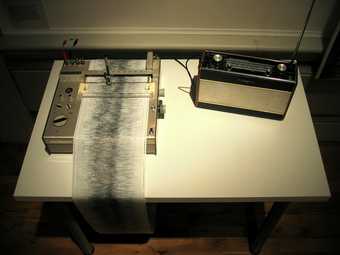
Fig.6
Jem Finer
Everywhere, All the Time 2005
Chart recorder, transistor radio and paper
Courtesy the artist
Photograph © Jem Finer
The automatic messages that are of concern to Finer – ‘an unreadable communication with its own inner sense’ – are of an impersonal, non-human nature (fig.7). Rendering literal the Bretonian metaphor of a simple recording instrument, Finer bypasses altogether the artist as expressive origin of the message: ‘Endless gyres, overwriting, obliterating, annihilating any pretence of analysis, the chart recorder is transformed into an automatic drawing machine, the universe the invisible hand.’38
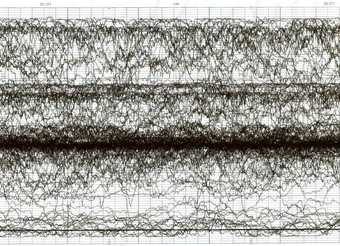
Fig.7
Jem Finer
Everywhere, All the Time 2005
Graphic trace from chart recorder
Courtesy the artist
Photograph © Jem Finer
It is fruitful to think about Finer’s practice in terms of a tension between noise and message as theorised by communication theory. Random noise can be understood as interference within a system of meaning production. In this respect, it might be understood to be quite similar to a Freudian slip, which manifests as an interruption or distortion of the intended message. However, the apparently chance or accidental nature of the latter turns out to be illusory and the lapsus is, in fact, subject to a strict psychic determinism. True randomness, which is the arena of contemporary practitioners’ interest, implies a breach in causality and hence ought not to be confused with the surrealist notion of objective chance, though it is compatible with the surrealists’ interrogation of the author function. The ratcheting-up of randomness undercuts the expressive paradigm of a subject who is the putative origin of a message.
Finer’s reference to a spirit hand resonates with surrealist automatism, whose derivation from mediumistic writing and drawing Breton acknowledged in his essay ‘The Automatic Message’ (1933). It also recalls a passage from the philosopher Roland Barthes’s famous text ‘The Death of the Author’ (1967) that implicitly appeals to the precedent of automatic writing: ‘the hand, cut off from any voice, borne by a pure gesture of inscription (and not of expression), traces a field without origin.’39 Barthes conceives of the writer not as expressive origin but rather as a kind of radio antenna picking up and remixing messages randomly absorbed. Tuning in to white noise instead of the overt communicative content of their chosen medium, postmodern artists perpetuate as well as update the historical avant-garde’s engagements with chance. In an essay on Cy Twombly, Barthes made an explicit analogy to white noise, writing of the picture Panorama 1955 (private collection) that: ‘The whole space is crackling in the manner of a television screen before any image appears on it.’40 Twombly reinterpreted an automatist practice in a manner contrary to the expressive paradigm that had dominated in the previous generation of artists. It is thus comparable to other gestures of cancellation, such as his friend Robert Rauschenberg’s Erased De Kooning Drawing 1953 (San Francisco Museum of Modern Art). The artist in the abstract expressionist mould was not only masculine, he was also stridently hetero-normative, a factor that art historian Jonathan Katz has argued lay behind the next generation of artists’ wish to distance themselves.41 Barthes refers to a new technological analogy for an automatist procedure in the television set, which, by the mid-1950s, had become nigh ubiquitous in American households. The origins of information theory in the immediate post-war period narrowly preceded the arrival of this new medium of mass communication. The white on black of Twombly’s Panorama evidently reminded Barthes of the cathode ray screen.
The experimental filmmaker Peter Rose explains that his sixteen minute film Secondary Currents 1982 is about the relationships between the mind and language: ‘A kind of comic opera, the film is a dark metaphor for the order and entropy of language.’42 In the course of the film, words – white on a black ground – gradually decompose into constituent letters that jostle in a random, Brownian motion, such that the screen becomes an almost literal representation of white noise (fig.8). Rose’s work relates to concrete poetry but also draws upon his mathematical training. In communication theory, the concept of entropy is closely related to randomness. As expounded by engineer John R. Pierce in his book Symbols, Signals and Noise (1961): ‘entropy increases as the number of messages among which the source may choose increases. It also increases as the freedom of choice (or the uncertainty to the recipient) increases and decreases as the freedom of choice and the uncertainty are restricted.’43
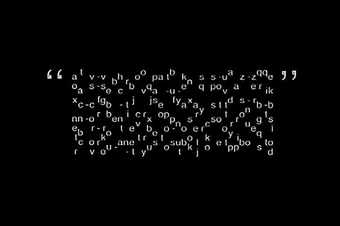
Fig.8
Peter Rose
Secondary Currents 1982
Still from film
16 minutes, 16 mm, black and white, sound
Courtesy the artist
Photograph © Peter Rose
Might it be possible to consider Rose’s language experiments as offering a route in to the final automatic text of Breton and Éluard’s ‘The Possessions’, the ‘attempt at simulating schizophrenia’ (‘démence précoce’), which plots a similar stepwise dissolution of language and sense? Under the guise of emulating the language of the insane, Breton and Éluard can be understood as exploring in an intuitive vein the relationship between a poetic or creative use of language and entropy. The act of collaboration seems to have been one means for interrupting the smooth flow of logical sense, an express aim of automatic writing being to divert language from its communicative function. In a manner not dissimilar to Rose, the schizophrenic treats words as things; their language was described in the kinds of manuals to which Breton and Éluard had access as propagating on the basis of chance associations or incidental resemblances between words. One can point to numerous examples of this in Breton and Éluard’s text. Within certain limits, an increase in randomness is experienced as poetic indeterminacy. However, the final paragraph of their exercise in simulation presses way beyond this threshold:
Fils de Judas rondève, qu’A Linné pasteur hippomythe U vraïli ouabi bencirog plaïol fernaca gla …lanco. U quaïon purlo ouam gacirog olaïama oual, u feaïva zuaïailo, gaci zulo. Gaci zulo plef. U feaïva oradarfonsedarca nic olp figilê. U elaïaïpi mouco drer hôdarca hualica-siptur. Oradargacirog vraïlim…u feaïva drer kurmaca ribag nic javli.44
Extraordinarily, this was among the texts that Samuel Beckett chose to translate.
The fact that The Magnetic Fields (1920), the true ur-texts of surrealist automatic writing, were composed jointly by Breton and Philippe Soupault (most obviously the texts called ‘Barrières’ (Barriers) which take the form of a dialogue or conversation) demonstrates that believing automatic writing to be the outpouring of a single unconscious is a misconception. In these texts, the writing subject makes use of an interlocutor in order to interrupt the flow and continuity of his discourse; a systematic interference with communicative language is thus built in to the procedure. It is a device that maximises incongruities. This can also be seen in the long distance collaboration of Ernst and Éluard in Les Malheurs des immortels. In his later comments on The Magnetic Fields, Breton placed great value on the speed of execution as the guarantor of the authenticity of a message that was to be as far as possible an uncorrupted record of unconscious thought. It is necessary to consider that the factor that comes increasingly into play as the speed of writing increases is not the unconscious but sheer randomness, which beyond a certain point manifests as a lexical decomposition.
Inspired by Marcel Duchamp’s 3 Standard Stoppages, and other artworks utilising chance, the New York conceptual artist William Anastasi began creating Pocket Drawings on folded sheets of paper while he was at the cinema in the 1960s. These led on to Subway Drawings that started as he was travelling to and from daily chess games with his friend, the composer John Cage, and which he has continued to produce (fig.9). Sitting with a pencil in each hand and a drawing board on his lap, his elbows at an angle of 90 degrees, his shoulders away from the backrest, Anastasi surrenders to a random process. His body operates likes a seismograph, allowing the rhythm of the moving train – its starts, stops and turns, accelerations and decelerations – to be transmitted onto the sheet of paper. In a 1990 interview, Cage talked about Anastasi’s modus operandi vis-à-vis surrealist automatism, insisting that: ‘It’s not psychological; it’s physical.’45
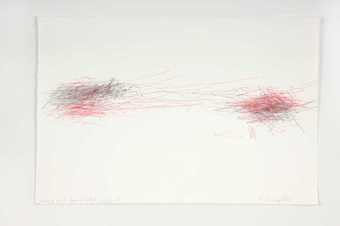
Fig.9
William Anastasi
Subway Drawing
Courtesy Gering & Lopez Gallery, New York
It is instructive to compare Anastasi’s Subway Drawings with another work that references the movement of a train and its effects on the human body, Marcel Duchamp’s Nude (Study), Sad Young Man on a Train 1911–12 (The Solomon R. Guggenheim Foundation,Peggy Guggenheim Collection, Venice).46 For Anastasi and the other artists in Cage’s circle, Duchamp was a cardinal reference point. The picture depicts the pipe-smoking artist on a train journey between Paris and Rouen. It is, Duchamp explained, a painting of ‘two parallel movements corresponding to each other’, that is to say, the forward velocity of the train together with the sideways rocking motion of the man standing in the crowded carriage.47 The passivity of a body acted upon by external mechanical forces is certainly akin to Anastasi’s Subway Drawings. The painting’s multiple registrations of a single figure, comparable to the more famous Nude Descending a Staircase 1912 (Philadelphia Museum of Art), reflects Duchamp’s preoccupation with Marey’s chronophotography. Moreover, the picture might be said to represent a quirky response to the futurist cult of machines and the dynamism of speed. Slightly perplexing is the undress of the solitary figure, who, it has been suggested, is depicted in a state of sexual arousal. What the picture represents, then, is a bachelor machine: the kinetic energy of the train transformed via the onanistic rhythms of a swaying body into libidinal energy. A helpful commentary on this state of affairs comes from faraway Vienna. Asserting that ‘mechanical agitation must be recognised as one of the sources of sexual excitation’, Freud, in Three Essays on the Theory of Sexuality (1905), specifically relates the pleasurable effects of this mechanical stimulus to train travel:
The shaking produced by driving in carriages and later by railway travel exercises such a fascinating effect upon older children that every boy, at any rate, has at one time or other in his life wanted to be an engine driver or a coachman. It is a puzzling fact that boys take such an extraordinarily intense interest in things connected with railways, and, at an age at which the production of phantasies is most active (shortly before puberty), use those things as the nucleus of a symbolism that is peculiarly sexual. A compulsive link of this kind between railway travel and sexuality is clearly derived from the pleasurable character of the sensation of movement.48
Freud contends that any physical stimulus to the body releases a quota of energy and this release of (libidinal) energy is felt as pleasurable. He instances the rocking of a child in order to put it to sleep. Duchamp wrote enigmatically of the period immediately preceding the First World War: ‘The machine, motion and eros were things which touched me in a poetic way. They were in the air and I felt I could use them for my art.’
Anastasi is well aware that his drawing could be seen as a displacement of a forbidden act. He says as much when he explains that he began making the Subway Drawings instead of the Pocket Drawings because he was concerned about what fellow passengers might think he was doing with his hands in his pockets. The drawing is done on a sheet of paper that rests directly on the artist’s lap. For a near equivalent, one must look to surrealism’s disreputable left field, to the sole example of what Salvador Dalí dubbed ‘espasmo-graphisme’. An inscription on the etching, purpose-made as a frontispiece to a collection of poems by Georges Hugnet titled Onan (1934), forthrightly confesses: ‘“ESPASMO-GRAPHISME” OBTAINED WITH THE LEFT HAND WHILE MASTURBATING WITH THE RIGHT HAND UNTIL BLOOD UNTIL BONE UNTIL SCAR!’ The image harks back stylistically to some tentative experiments by Dalí with an automatic technique in the late 1920s, quickly abandoned as he evolved his more characteristic illusionism. The jagged, staccato rhythms of the compulsively repeated doodles mime the action believed to have been carried out with the artist’s other hand. There is a crucial distinction to be drawn between illustrating the act of masturbation, which Dalí plainly was not reluctant to do, and producing a non-representational, so to speak, automatic trace of the activity, as he does here. Using his left hand to engrave the plate – Dalí was right-handed – eliminates at one stroke any semblance of manual skill or virtuosity. One is reminded that for Freud the solitary vice of masturbation was a frequent cause of neurosis. If this opinion, oddly indebted to Victorian prudery, is accepted for a moment, then Dalí chooses the shortest possible route between the supposed forbidden activity and its unfettered, automatic expression.49 But in doing so, it seems that he short-circuits the whole Freudian apparatus of the unconscious and repression. An area of staining across the centre of the sheet raises other questions for the inquisitive critic: does it merely simulate what it purports to be, or is it the forensic evidence one is searching for, the veridical trace that authenticates the automatic message? Granted, the work is parodic in intent, tossed off in a matter of minutes, but it is nonetheless a wry, amusing commentary on the discourse and practice of surrealist automatism.
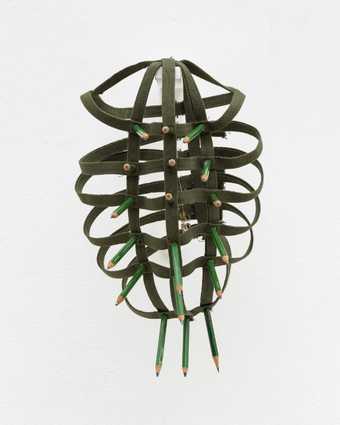
Rebecca Horn
Pencil Mask
(1972)
Tate
Finally, Rebecca Horn’s Pencil Mask 1972 (fig.10) is a sort of mechanical prosthesis that transforms the artist into a drawing machine. It is a sinister and disturbing piece, more autistic than artistic. Horn describes its operation thus: ‘All the pencils are about two inches long and produce the profile of my face in three dimensions … I move my body rhythmically from left to right in front of the white wall. The pencils make marks on the wall the image of which corresponds to the rhythm of my movements.’50 Strapped around her face, the harness turns the wearer into a blind automatic drawing instrument. There is not space here to do justice to this arresting work, nor to tease out its relation, on the one hand, to her robotic painting machines or the pseudo-expressivity of her later Artaud-like drawings.51 The key point, however, is the way it encircles the artist’s head, interposing a physical barrier between the artist and the sheet of paper. The ‘unconscious’ is simply bracketed off from whatever is going on. Horn and the other contemporary artists discussed here point to ways of understanding surrealist automatism beyond the impasses of the assumption that such works are, or ever were, the expression of such a thing.

